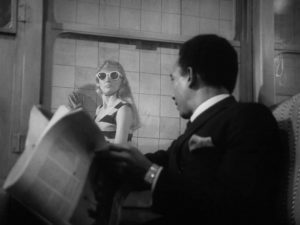The Severity of Discrimination
The Dutchman and Equality
by Çağla Nihan Atik
 The Dutchman (1967), a one-act play by Amiri Baraka, promotes equality through the black character, Clay, who is a self-made, middle-class man. It mainly revolves around two characters: a beautiful, white woman, Lula, and him. The play is built upon the constant tension hanging between the characters. Lula is the main source of this tension with her racist and insolent attitude towards him. Even though the play is not considered to be dystopian or horror fiction, both the audience and Clay experience fear because of this uncertainty. She is an unstable character with evil intentions, and she displays it most solidly. The narrative uses apple as an indicator of her danger—she eats an apple and offers some to Clay. It is a reference to the figure of Eve—a seemingly beautiful but dangerous woman who will have Adam fall from Heaven. Moreover, Clay’s name is also important in terms of the narrative due to its reference to his skin color. The play is designed to make the audience focus on what the play leads them to the racism and its effects on people. The instability of Lula is supported by the setting of the play: a subway car. The characters are on the way from the beginning to the ending. The quantity of the passengers is also changeable and even when other passengers exist, they do not seem like they care about what is happening between the two. Also, Lula is constantly moving and dancing. The text uses these references and metaphors in such a way that it is rather easy to conceive the mood of the play—get into the atmosphere of the play. Lula’s instability towards Clay makes the tension much stronger and the ugliness of her racism more effective.
The Dutchman (1967), a one-act play by Amiri Baraka, promotes equality through the black character, Clay, who is a self-made, middle-class man. It mainly revolves around two characters: a beautiful, white woman, Lula, and him. The play is built upon the constant tension hanging between the characters. Lula is the main source of this tension with her racist and insolent attitude towards him. Even though the play is not considered to be dystopian or horror fiction, both the audience and Clay experience fear because of this uncertainty. She is an unstable character with evil intentions, and she displays it most solidly. The narrative uses apple as an indicator of her danger—she eats an apple and offers some to Clay. It is a reference to the figure of Eve—a seemingly beautiful but dangerous woman who will have Adam fall from Heaven. Moreover, Clay’s name is also important in terms of the narrative due to its reference to his skin color. The play is designed to make the audience focus on what the play leads them to the racism and its effects on people. The instability of Lula is supported by the setting of the play: a subway car. The characters are on the way from the beginning to the ending. The quantity of the passengers is also changeable and even when other passengers exist, they do not seem like they care about what is happening between the two. Also, Lula is constantly moving and dancing. The text uses these references and metaphors in such a way that it is rather easy to conceive the mood of the play—get into the atmosphere of the play. Lula’s instability towards Clay makes the tension much stronger and the ugliness of her racism more effective.
The most effective scene of the play is, surely, when Clay gives his soliloquy. In his speech, he reveals his suppressed anger towards not only Lula but the society. He states that their way of producing and expressing themselves through music and art is their way of coping with the oppression because of their color. Here, the play also emphasizes the black people artistic achievements which white people enjoy. It reveals and shakes the audience to realize the importance of art and music in sublimating the anger and aggression within the oppressed people. As a response to his expression, Clay is stabbed by Lula harshly and abruptly to death. The saddest part also comes after his death. Lula is just telling the other passengers to throw the body of Clay out of the subway car as if it is garbage, and Lula returns to her life as a respectable white woman. The play shows the audience how a person’s dignity counts as nothing in face of discrimination. After all of Clay’s beautiful and effective words, due to the lack of values, those words become thin air as if they mean nothing. The Dutchman uses the elements of narration and fiction to create an atmosphere realistic as unrealistic. By creating racist aggression in its extremes, the play shows the audience the ugly consequences of discrimination and inequality.

